Project Wolbachia - Singapore
National Environment Agency
by Kenneth Lyen

NATIONAL ENVIRONMENT AGENCY MOSQUITO PRODUCTION FACILITY
I visited the National Environment Agency’s (NEA) new mosquito production facility established to fight against the Aedes aegypti mosquito in September 2019. This mosquito has been responsible for several viral infections, including dengue, zika and chikungunya, causing death and debilitating illnesses in many parts of the world. The NEA’s fight against mosquito employs an exciting innovative strategy, using Wolbachia bacteria to stop eggs laid by female mosquitoes from hatching (1). Already, the mosquito population in those areas in Singapore where this tactic has been employed, has fallen by more than 90 percent. Let us examine the history of the program.

HISTORICAL BACKGROUND
Named after American pathologist Simon Wolbach (1880-1954), this gram-negative bacteria has been found in about 60% of all insect species, including fruit flies and mosquitoes, they can also be found in roundworms (2). In 1971, Janice Yen and Ralph Barr observed that when a male Wolbachia-carrying mosquito fertilises an uninfected female, that female will lay eggs but they will fail to hatch. The reason for the egg’s infertility is because of cytoplasmic incompatibility (3).
The Wolbachia bacteria can be found in some mosquito species including Culex species and Aedes albopictus, but not in Aedes aegypti. In 2005, Prof Zhiyong Xi transferred Wolbachia from Aedes albopictus to Aedes aegypti using a microinjection technique (4). To demonstrate that the Wolbachia could survive and multiply (5,6) in the Aedes aegypti mosquito, a field trial was done in Cairns, Australia in 2011. The release of 300,000 Wolbachia-infected mosquitoes continued in this restricted area, and over the next few years, there was a 93% reduction in the reported incidence of dengue fever (7). In 2014, Vietnam (8) and Brazil (9) started a trial of Wolbachia-infected Aedes aegypti mosquitoes. A similar trial was started in 2017 in Indonesia (10). The Australian, Vietnam and Indonesian trials employed both infected male and female mosquitoes.

PROJECT WOLBACHIA - SINGAPORE
This is part of NEA’s continued efforts to augment Singapore’s vector control strategy with new tools and innovations. Enhanced vector control will help Singapore better confront the threat of climate change, which is expected to worsen the transmission of mosquito-borne diseases over the next few decades.
This trial differed from those mentioned above in that only the male Wolbachia-carrying Aedes aegypti mosquitoes were released. The advantage of using only male mosquitoes is that they do not bite, and therefore residents are not deluged with biting female mosquitoes. Over the next few years, the field studies expanded to cover more neighborhoods areas The results are very encouraging, with more than 90 per cent suppression at the study sites.
Currently in Phase 4, Project Wolbachia has expanded to cover about 56,000 households, which is about 14- fold expansion compared to the small scale field study. So the obvious question is how do you breed so many mosquitoes, and how do you infect the eggs with Wolbachia?

To find out, I was allowed in the sparkling new NEA mosquito production facility. The entry double sliding doors were specially designed to stop mosquitoes escaping. The rooms are painted all-white and you can view the activities through large glass windows. I was first shown the breeding room where animal blood is used to feed the female mosquitoes for egg production, and sugar water to feed the males. There were special rearing cages protected by netting that allows observers to watch the mosquitoes, but they were a bit too far away for me to spy upon their mating with one another.

THE MOSQUITO
The male mosquito typically lives about 3-5 days after release, but apparently they can enjoy mating with multiple females in their short life-span. The female generally mate only once, and they can lay around 300 eggs in her 2-3 weeks’ lifespan.
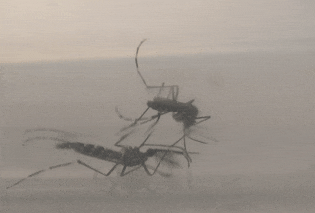
Above are two mosquitoes mating with each other. There are containers filled with water and oviposition substrates are provided for the females to lay their eggs.
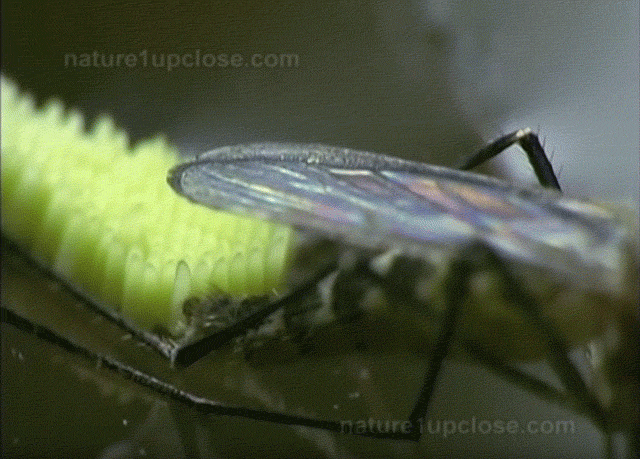
The room temperature is kept nice and warm at around 28 degrees Celsius and 80% relative humidity.

The eggs were microinjected with Wolbachia bacteria. Initially I thought all the eggs were microinjected, which is a tedious process. However, I was informed that this only took place for the very first few batches of eggs. Once the infected mosquitoes hatched, they were then reared to produce more eggs, all of which would carry the Wolbachia bacteria. Hence there is no need to keep on microinjecting the eggs.

The above picture shows a larva hatching from an egg. The successfully hatched larvae are counted automatically by a Singapore-invented counting and dispensing machine.
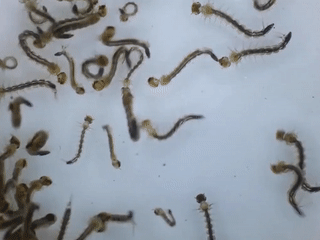

The newly hatched larvae are allowed to swim about a warm water pool. They moult 4 times before developing into pupae at about 6 days.

The male mosquito pupae are separated from the female purely on their smaller size.

Two glass plates slightly wider on top and narrower on the bottom allows the smaller males to flow down, and they are collected and placed in special male-only water containers.

A new machine co-developed by NEA-EHI and Orinno Technology Pte Ltd (local company) automates this process and allows much faster separation of male and female mosquito pupae. The error rate in the separation of male from female mosquitoes is about 0.2%.
%20a.jpg)
However, NEA has a x-ray machine that delivers a low dose of irradiation to sterilise the few females that may have accidentally slipped through the separation process.
These pupae are counted and packed in containers to be released in the next two to three days.
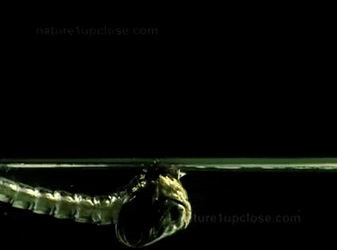
The mosquito emerges from the pupa. They should be all males.

The adult male mosquitoes are then placed in a warm enclosure.

You can put your hand in these enclosures and the male mosquitoes might land on your arm, and amazingly they do not bite.

Another local invention, the Mosquito Launcher, which looks like a series of cannons, will fire male mosquitoes into the environment at the press of a button. This is followed by a gentle stream of air to blow out any remaining mosquitoes within the device.

Several areas in Singapore have been chosen to release these sterile males. The male Wolbachia-Aedes mosquitoes will seek out a female partner, mate, and the female will lay non-viable eggs.
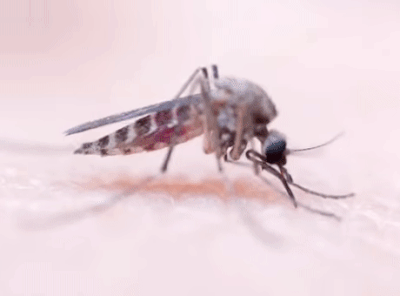
THE FUTURE
The success of the project has been confirmed by the fall in the mosquito population by 90%. However, the incidence of dengue in Singapore is over 300 new cases per week, which is too high. The limitation is that the areas where Wolbachia-carrying mosquitoes released are still too small. Is it possible to accelerate this expansion? That is certainly on the cards for the future.
NEA has introduced many novel ways of automating and accelerating the entire process, and they are planning to continue with these Singapore innovations.
The reduction of dengue fever requires a multi-pronged approach with continuation of source reduction which includes removal of stagnant water, insecticide fogging in outbreak clusters, the use of mosquito repellants, and the development of a better vaccine to prevent dengue.
We wish NEA all the very best in their efforts to reduce the mosquito population, or perhaps eradicate all mosquitoes!
ACKNOWLEDGEMENTS
I thank Kathryn Vasquez and Dr Chong Chee Seng of the National Environment Agency for their tremendous help and patient explanation of the Wolbachia Project.
REFERENCES
1. Project Wolbachia by the National Environmental Agency:
ttps://www.nea.gov.sg/media/news/news/index/new-nea-facility-to-boost-production-of-male-wolbachia-aedes-aegypti-mosquitoes-to-benefit-more-residents
2. Wolbachia: https://en.wikipedia.org/wiki/Wolbachia
3. Janice Harumi Yen and Ralph Barr: Cytoplasmic incompatibility in Culex pipiens (1971):
https://www.researchgate.net/publication/18232137_New_hypothesis_of_the_cause_of_cytoplasmic_incompatibility_in_Culex_pipiens_L_31
4. Transferring Wolbachia to Aedes aegypti by microinjection: Zhiyong Xi et al (2005):
5. Mains et al. 2016. Female adult Aedes albopictus suppression by Wolbachia-infected male mosquitoes.
Nature Scientific reports DOI:10.1038/srep33846
6. Zheng et al. 2019 Incompatible and sterile insect techniques combined eliminate mosquitoes.
Nature. DOI:10.1038/s41586-019-1407-9
7. Australian trial of Wolbachia-infected mosquitoes (2011):
https://www.theguardian.com/society/2018/aug/01/dengue-fever-outbreak-halted-by-release-of-infected-mosquitoes
https://www.worldmosquitoprogram.org/sites/default/files/december_2011_trial_update_-_cairns.pdf
https://www.ncbi.nlm.nih.gov/pmc/articles/PMC5807169/
8. Vietnam trial of Wolbachia-infected mosquitoes (2014):
https://parasitesandvectors.biomedcentral.com/articles/10.1186/s13071-015-1174-x
9. Brazil trial of Wolbachia-infected mosquitoes (2014):
http://www10.who.int/bulletin/volumes/94/8/16-020816/en/
10. Indonesia trial of Wolbachia-infected mosquitoes (2017):
https://www.ncbi.nlm.nih.gov/pubmed/29855331
11. Singapore trial of male Wolbachia-infected mosquitoes (2016):
https://www.nea.gov.sg/corporate-functions/resources/research/wolbachia-aedes-mosquito-suppression-strategy/project-wolbachia-singapore
https://www.nea.gov.sg/media/news/news/index/new-nea-facility-to-boost-production-of-male-wolbachia-aedes-aegypti-mosquitoes-to-benefit-more-residents
12. Incidence of dengue fever in Singapore: Dengue Cases
Written by Kenneth Lyen
30 Sept 2019, revised 13 April 2020
%20a.jpg)
